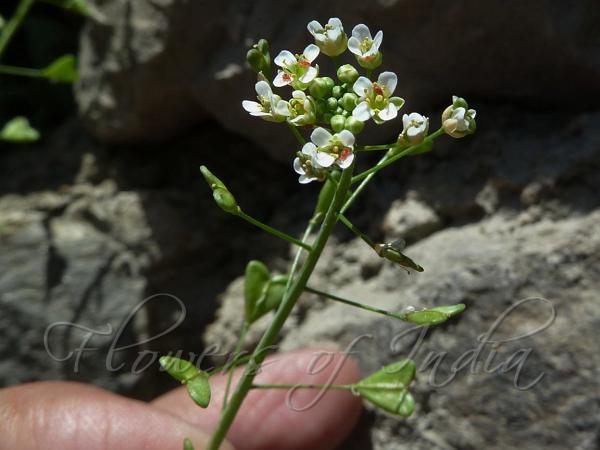|
| Shepherd's Purse |
|

|

| File size | 188429 |
| Original date | 6/14/14 12:35 PM |
| Resolution | 2560 x 1920 |
| Flash | Flash did not fire, auto |
| Focal length | 4.1mm |
| Exposure time | 1/500s |
| Aperture | 4.5 |
| Focus Distance | |
| Metering Mode | Multi-segment |
| Camera make | Panasonic |
| Camera model | DMC-TZ10 |
| Sensor type | OneChipColorArea |
|
|
|
|
Photo: |
Botanical name: Capsella bursa-pastoris Family: Brassicaceae (Mustard family)
Shepherd's Purse is originally from Europe, but has become very common in
many parts of the world. The species name bursa-pastoris mean
purse of the shepherd. This name refers to the fruit-capsule in the shape
of a triangle, attached to slender stalk from its pointy end, with a notch
on the top. Shepherd's Purse grows in gardens, fields, waste grounds, and
embankments with soils that are not too dry and that provide enough
sunshine. This is rather a small plant, growing to 6-20 cm high. The basal
leaves are lanceolate and dentate. The white flowers are arranged in loose
racemes. Flowers are radially symmetrical with four petals.
The seeds of this plant give off a viscous compound when moistened. Aquatic
insects stick to it and eventually die. This can be used as a mosquito
control method, killing off the mosquito larvae, and makes it a borderline
carnivorous plant. The seeds, leaves, and root of this plant are edible. In
China, it is commercially grown for consumption.
Flowering: December-January.
Medicinal uses: In Manipur, it has been used to stop bleeding from internal organs.
In Manipur, it has been used to stop bleeding from internal organs.
Medicinal uses:
 In Manipur, it has been used to stop bleeding from internal organs.
In Manipur, it has been used to stop bleeding from internal organs. | Identification credit: Tabish | Photographed in Lahaul, Himachal Pradesh & Shanti Van, Delhi. |
• Is this flower misidentified? If yes,